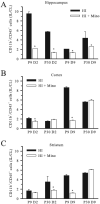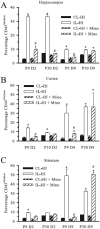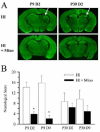Suppression of microglia activation after hypoxia-ischemia results in age-dependent improvements in neurologic injury
- PMID: 26857490
- PMCID: PMC4748173
- DOI: 10.1016/j.jneuroim.2015.12.004
Suppression of microglia activation after hypoxia-ischemia results in age-dependent improvements in neurologic injury
Abstract
We previously found increased microglial proliferation and pro-inflammatory cytokine release in infant mice compared to juvenile mice after hypoxia-ischemia (HI). The aim of the current study was to assess for differences in the effect of microglial suppression on HI-induced brain injury in infant and juvenile mice. HI was induced in neonatal (P9) and juvenile (P30) mice and minocycline or vehicle was administered at 2h and 24h post-HI. P9 minocycline-treated mice demonstrated early but transient improvements in neurologic injury, while P30 minocycline-treated mice demonstrated sustained improvements in cerebral atrophy and Morris Water Maze performance at 60days post-HI.
Keywords: Cerebral atrophy; Microglia; Neonatal hypoxia–ischemia; Neuroinflammation.
Copyright © 2015 Elsevier B.V. All rights reserved.
Figures








References
-
- Biran V, Joly LM, Heron A, Vernet A, Vega C, Mariani J, Renolleau S, Charriaut-Marlangue C. Glial activation in white matter following ischemia in the neonatal P7 rat brain. Exp. Neurol. 2006;199:103–12. - PubMed
-
- Bonestroo HJ, Nijboer CH, van Velthoven CT, Kavelaars A, Hack CE, van Bel F, Heijnen CJ. Cerebral and hepatic inflammatory response after neonatal hypoxia-ischemia in newborn rats. Dev. Neurosci. 2013;35:197–211. - PubMed
-
- Buller KM, Carty ML, Reinebrant HE, Wixey JA. Minocycline: a neuroprotective agent for hypoxic-ischemic brain injury in the neonate? J. Neurosci. Res. 2009;87:599–608. - PubMed
-
- Butovsky O, Jedrychowski MP, Moore CS, Cialic R, Lanser AJ, Gabriely G, Koeglsperger T, Dake B, Wu PM, Doykan CE, Fanek Z, Liu L, Chen Z, Rothstein JD, Ransohoff RM, Gygi SP, Antel JP, Weiner HL. Identification of a unique TGF-beta-dependent molecular and functional signature in microglia. Nat Neurosci. 2014;17:131–43. - PMC - PubMed
-
- Campanella M, Sciorati C, Tarozzo G, Beltramo M. Flow cytometric analysis of inflammatory cells in ischemic rat brain. Stroke. 2002;33:586–92. - PubMed
Publication types
MeSH terms
Substances
Grants and funding
LinkOut - more resources
Full Text Sources
Other Literature Sources
Medical

